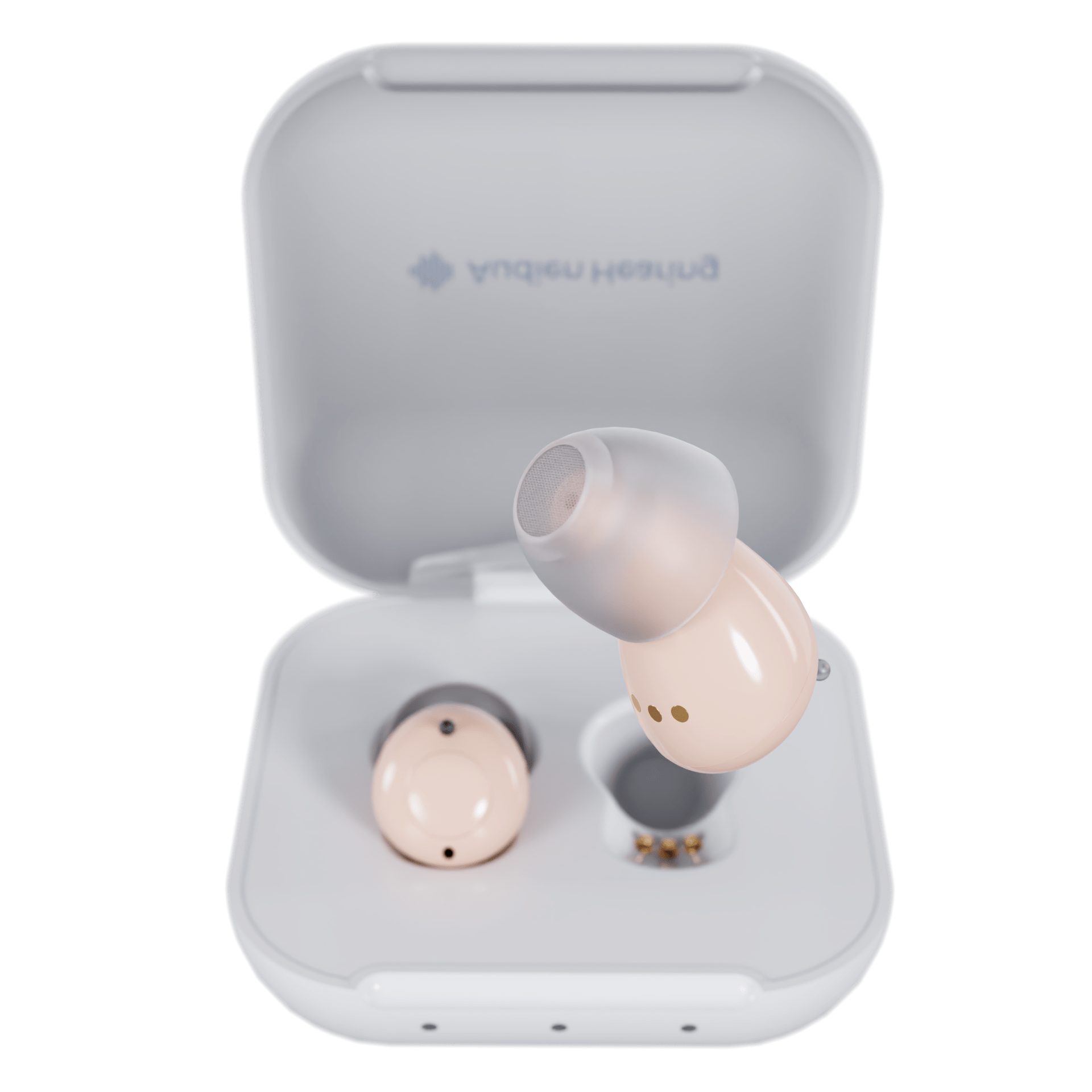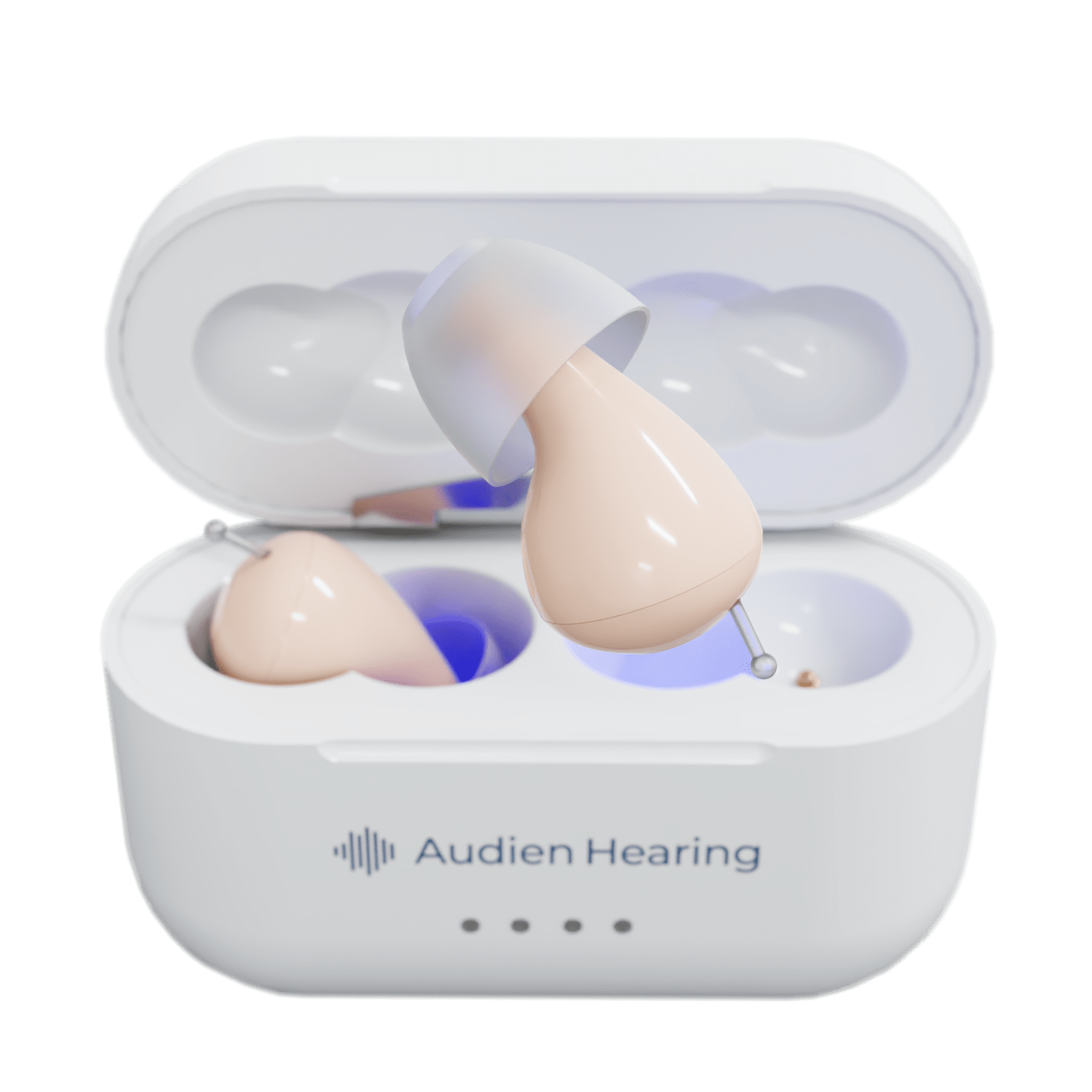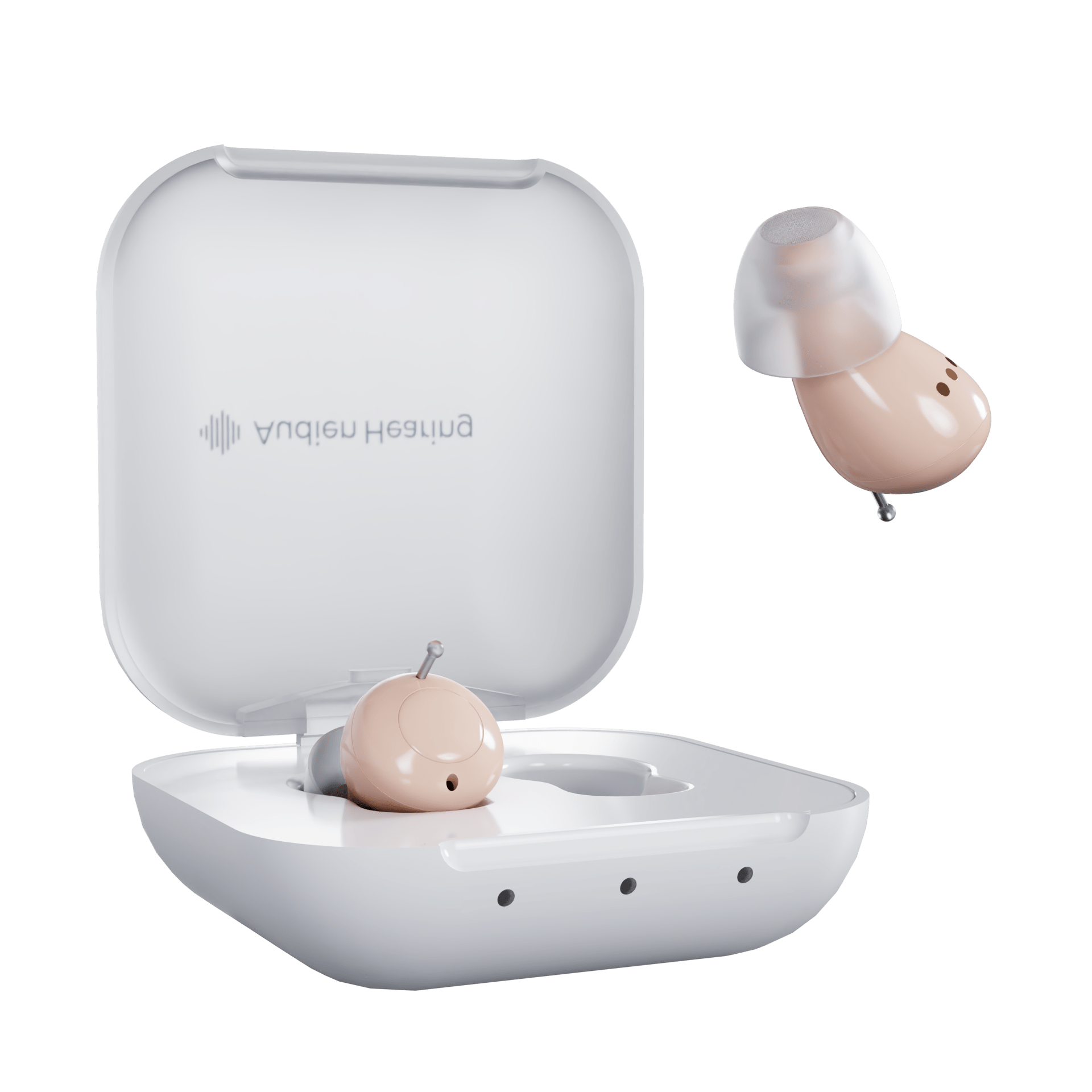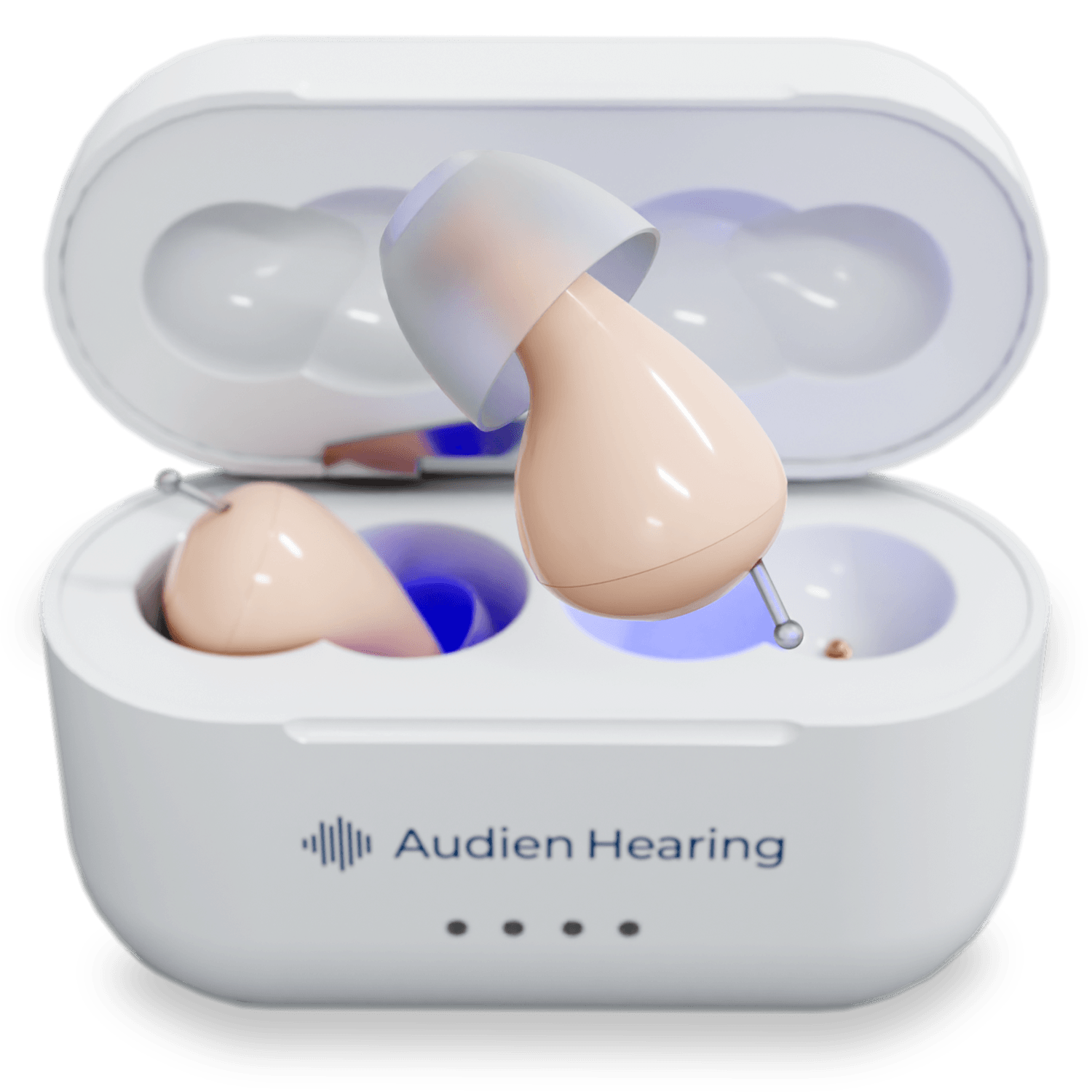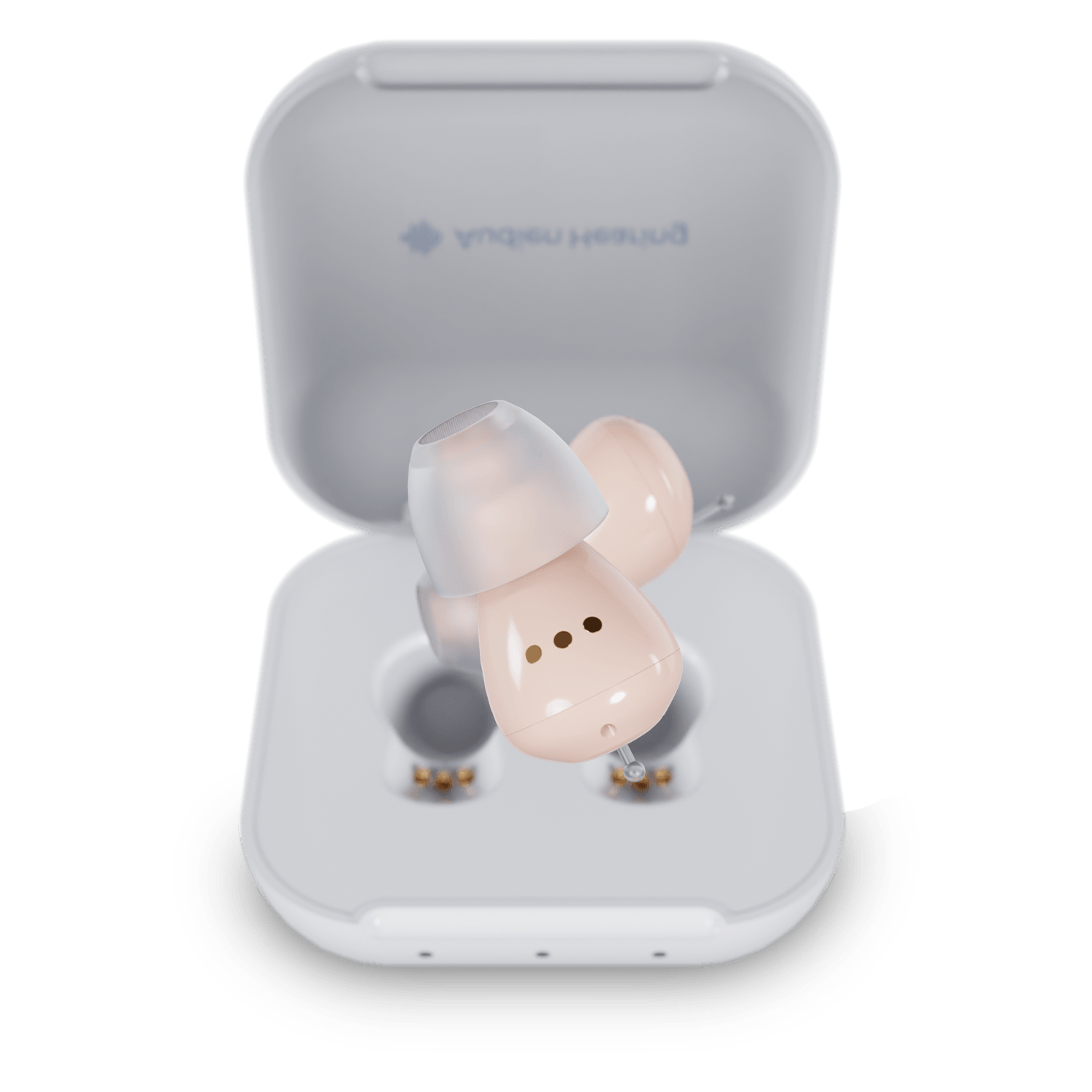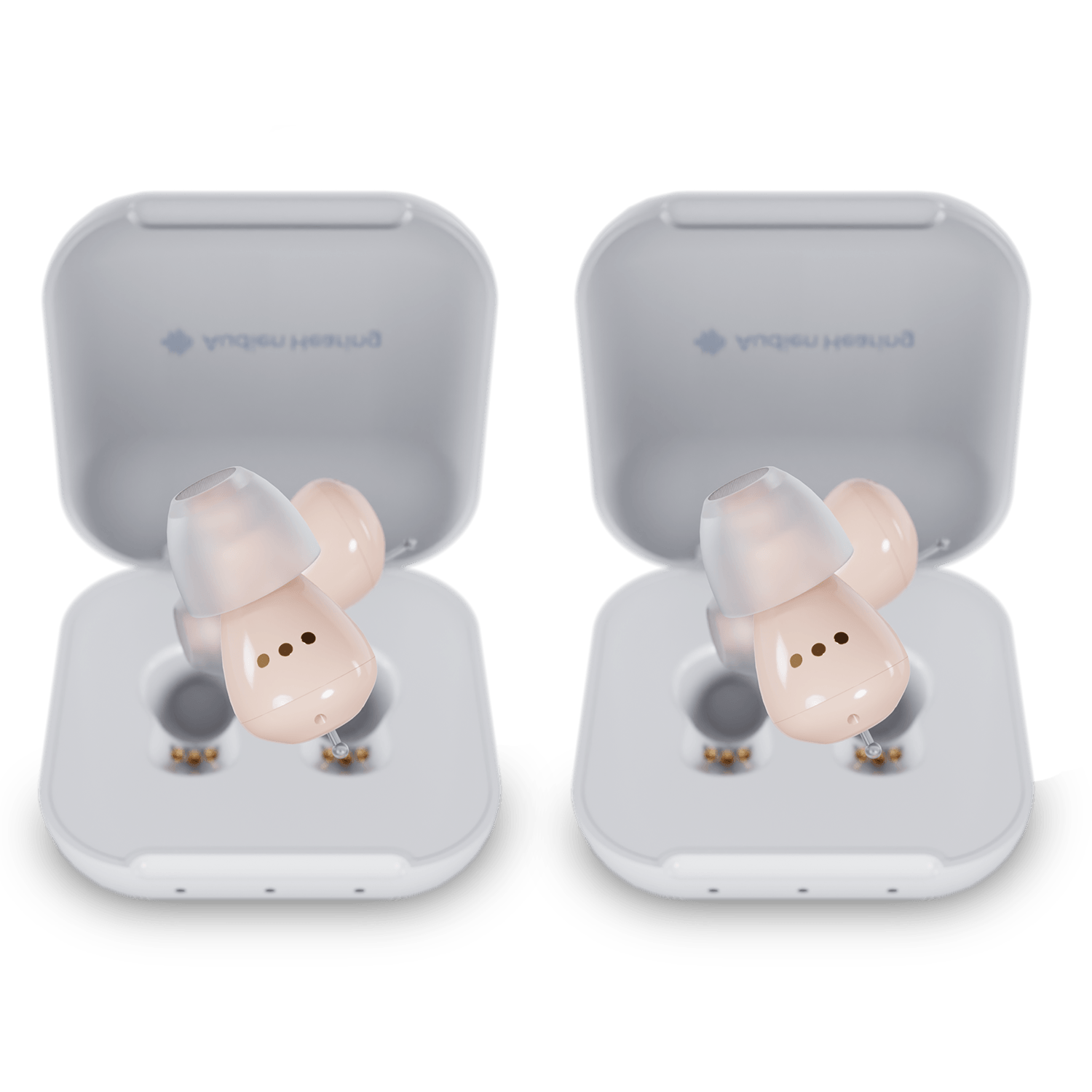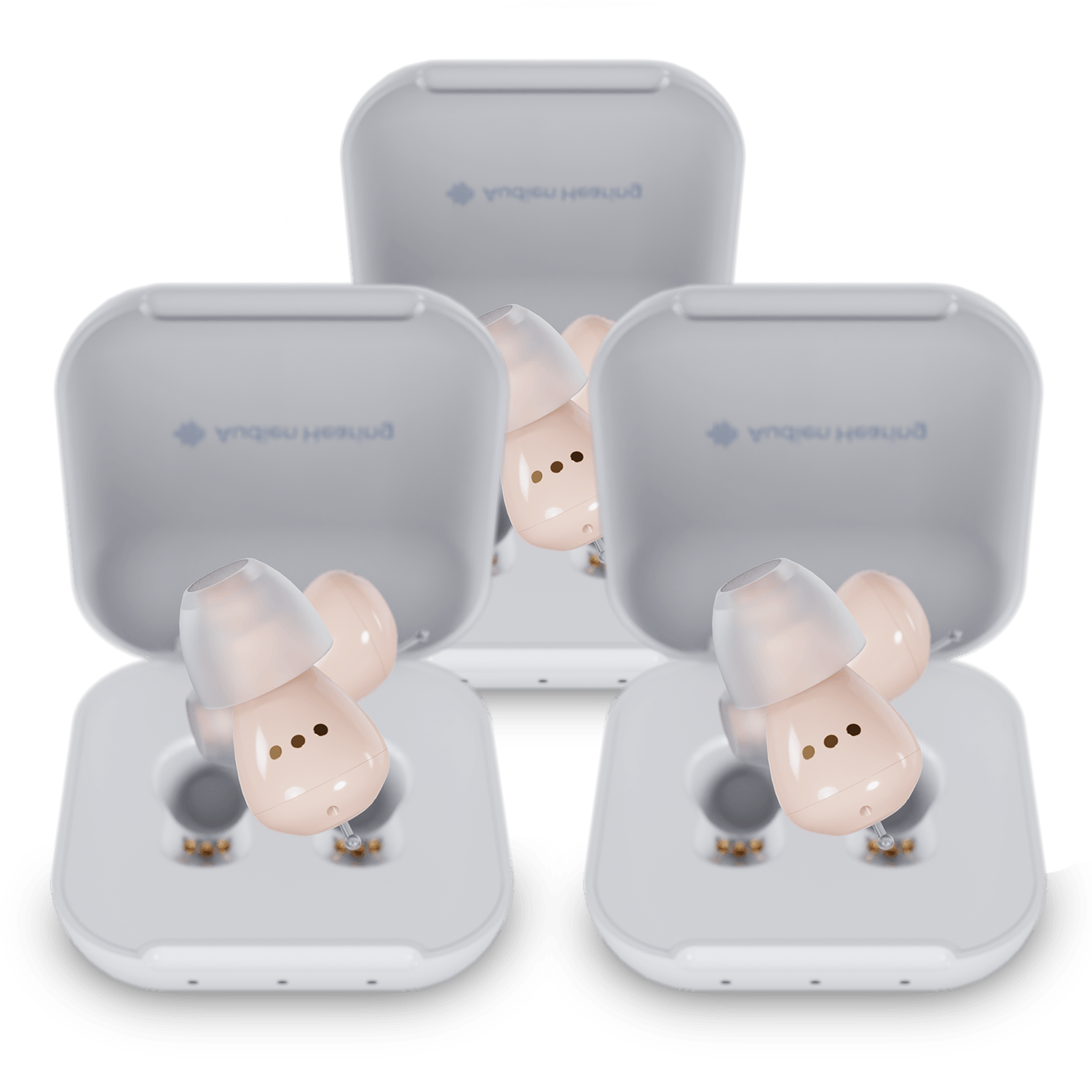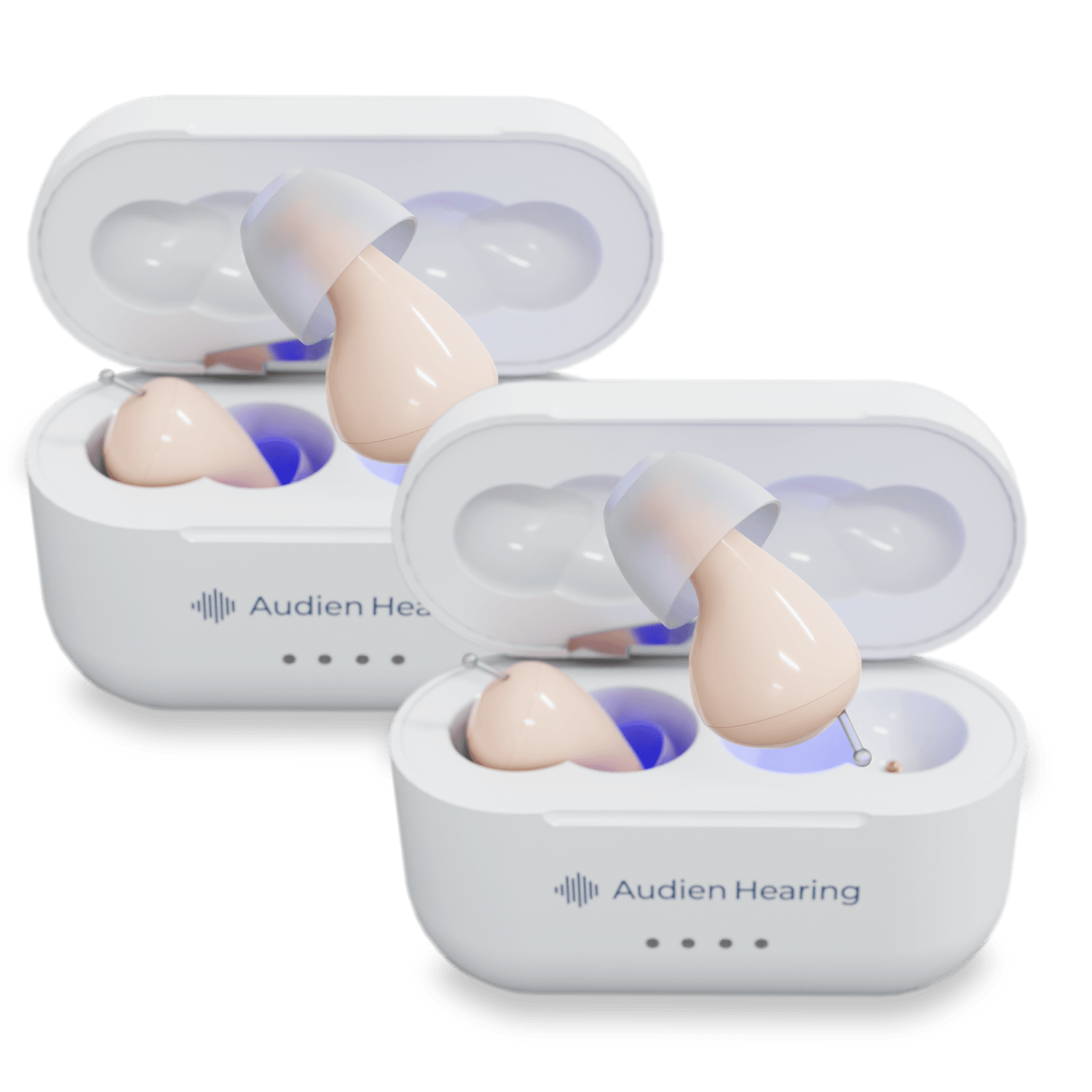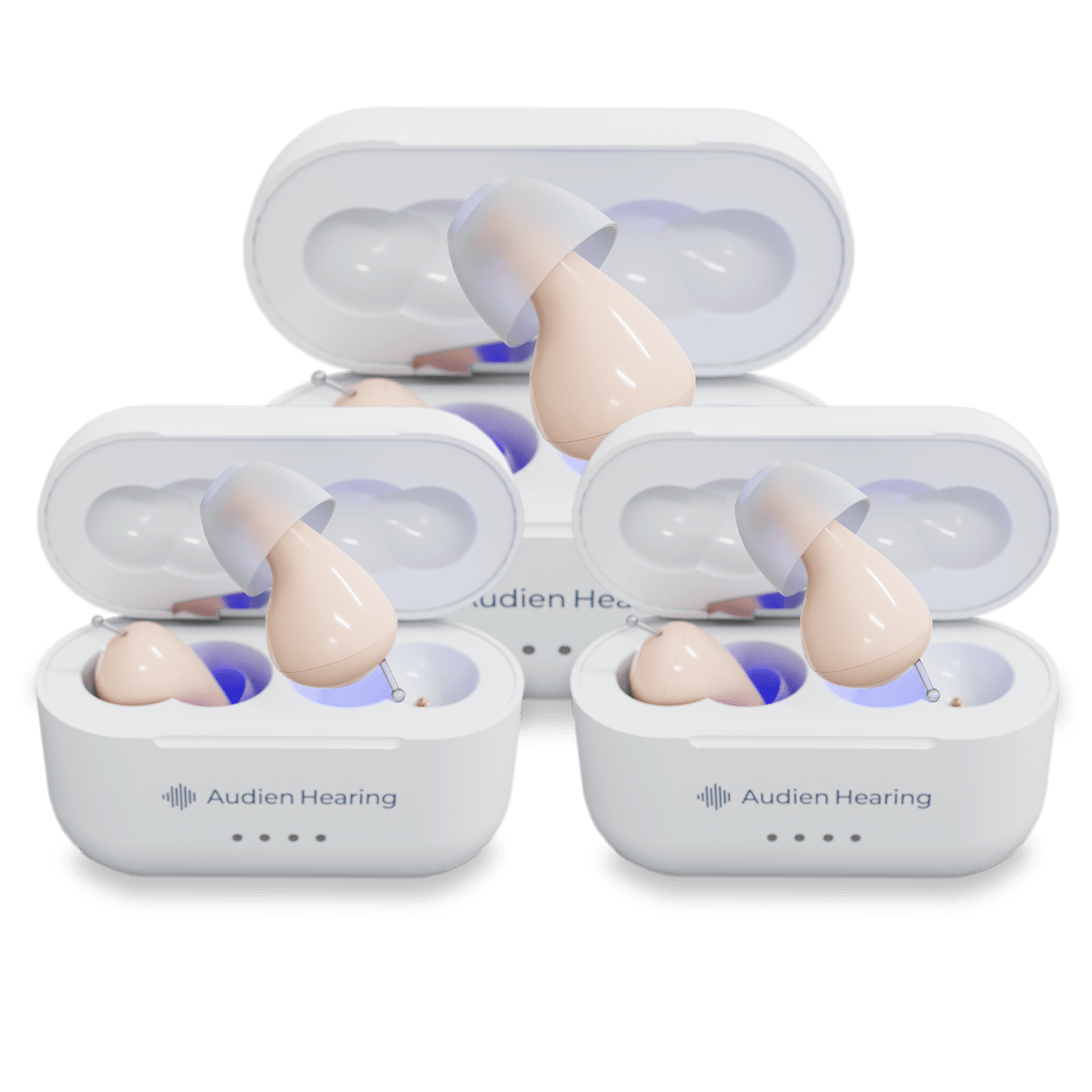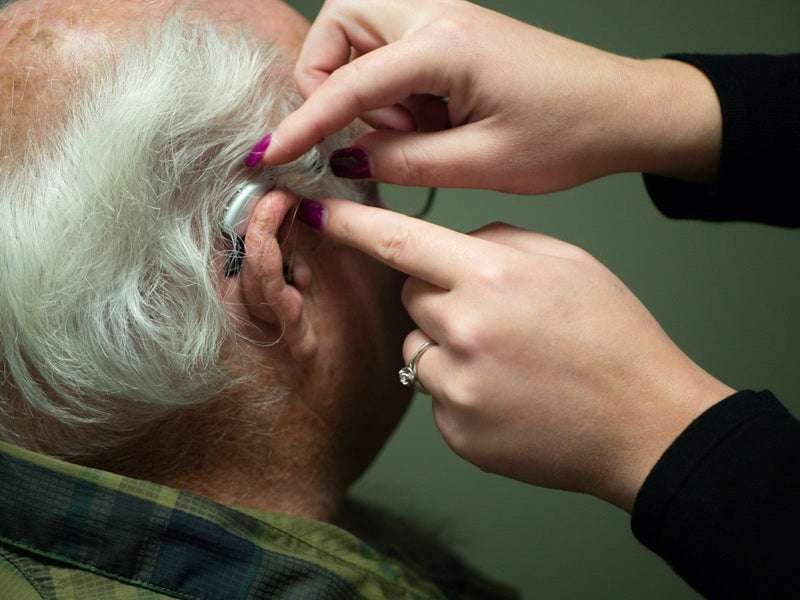Hearing loss can strain everything from work to relationships, whether it’s mild or profound loss you’re struggling with. Fortunately, you don’t have to suffer in silence. There are so many great options at your disposal in 2025.
We see Phonak vs Signia hearing aids compared all the time, and it’s easy to see why. Each of these brands produces premium, prescription-grade hearing aids with ultra-sophisticated technology.
You really can’t go wrong either way if you’re dealing with profound hearing loss that has taken a toll on your life. You’ll gain access to behind-the-ear (BTE), receiver-in-canal (RIC), in-the-ear (ITE), and invisible-in-canal (IIC) styles.
Both are powered by reliable sound processing, loaded with intuitive features, and are backed by audiologist support depending on the clinic you purchase them through. So, we’ll take a closer look at Signia hearing aids vs Phonak hearing aids below to help you narrow it down.
That said, not all instances of hearing loss call for such a sophisticated solution. In fact, these are really expensive and hard to justify for someone with mild to moderate hearing loss. In these cases, you may be better off with the best OTC hearing aids at Audien Hearing.
Our devices start at $98 and don’t require any sort of doctor’s visit or hearing test. You can buy hearing aids online today and start hearing clearly straight out of the box. Place your order with peace of mind backed by our 45-day risk-free trial and lifetime support!
“Every bit as good as the $6,000 phonak I've been using. If this is your first pair, be patient because any new pair takes some getting used to. Good luck with audien-you will be happy you got them.” - Nancy
“I have had a hearing aid for the past 7 years, made by Phonak, that cost me $6000. It takes batteries once a week. It didn't work! I decided to try the Audien Hearing device, it was a miracle. I could hear again with absolute clarity, and I could regulate the volume of the device.” - Stuart
“Ordered a new pair of Hearing aids last month. Had an issue with one out of the box... Customer Support response was great... Made everything right. Thanks Vena.” - Spike
Quick Comparison of Signia vs Phonak Hearing Aids
| Feature | Phonak | Signia | Audien Hearing |
|---|---|---|---|
| Type of Hearing Aid | Prescription only | Prescription only | Over-the-counter (OTC) |
| Best for | Mild to profound hearing loss | Mild to profound hearing loss | Mild to moderate hearing loss |
| How to Buy | Clinic or audiologist only | Clinic or audiologist only | Direct online purchase |
| Fitting & Support | In-person fitting; remote support available | In-person fitting; remote TeleCare available | Self-fit; lifetime customer support |
| Bluetooth Streaming | Universal Bluetooth (iOS & Android) | Limited to select devices; LE Audio on new models | Available on Ion and Ion Pro only |
| Rechargeable Options | Yes | Yes | Yes |
| Price Range (per pair) | $3,000 – $7,000 | $3,000 – $7,000 | $98 – $689 |
| Professional Adjustment Required | Yes | Yes | No |
| Trial Period | Varies by clinic | Varies by clinic | 45-day risk-free trial |
| Warranty | 1–3 years (clinic dependent) | 1–3 years (clinic dependent) | Lifetime support included |
Phonak Hearing Aids: Models, Price, and Support
Phonak is a global hearing aid manufacturer owned by Sonova, a company known for clinical-grade innovation. These prescription devices must be fitted by licensed professionals, so you will need to schedule an appointment to find out for sure if they’re the ideal fit.
But, those with profound hearing loss consider Phonak to be the gold standard. They bring you universal Bluetooth streaming, advanced signal processing, and proprietary accessories like the Roger system.
Models and Key Features
Phonak’s current lineup centers on the Lumity platform, which replaced Paradise as the flagship system in 2022. The core technology, AutoSense OS 5.0, automatically detects/adapts to your environment in real-time, from serene sidewalks to chaotic restaurants. Here’s a closer look:
- Audéo Lumity: An RIC model for mild to severe hearing loss, available in rechargeable and disposable battery options. Directional microphones, motion-based sound adjustment, and tap control for calls and media.
- Naída Lumity: A BTE device for users with more significant hearing loss. Offers high-output amplification, stereo streaming, and compatibility with Roger microphones.
- Slim Lumity: Combines the Lumity platform with a more discreet, ergonomic design for aesthetic-conscious users who want a modern fit and modern technology.
- Virto Paradise: A custom-molded, ITE option (not yet on Lumity), including Bluetooth functionality in certain versions. A good candidate for users focused on discretion.
- Sky Lumity: Designed for pediatric use. It has tamper-proof features, ruggedized casing, and compatibility with classroom hearing systems.
- Lyric: A fully invisible device worn deep in the ear canal for months at a time. It’s not programmable at home and must be inserted and maintained by a trained provider. The ideal choice for users who want to wear their device 24/7 without anyone knowing.
Motion Sensor Hearing, SpeechSensor, and dynamic noise cancellation are standard in upper-tier models, but you get universal Bluetooth connectivity (compatible with iOS, Android, and virtually any Bluetooth-enabled device) across the product range.
Pricing and Where to Buy
You can only get Phonak devices through licensed hearing clinics, not online or over-the-counter. It’s hard to give you a direct estimate on price since it depends on the provider’s markup, bundled services, and the actual device you get fitted with.
That said, a pair of Phonak hearing aids ranges from $3,000 to $7,000 on average, which includes fitting, follow-ups, and accessories. Most providers offer tiered pricing based on the level of automation and signal processing you need.
Support and Follow-Up Care
You should expect an ongoing relationship with your provider since Phonak devices require professional programming and adjustments. The initial fitting will involve real-ear measurements and patient counseling.
Adjustments, firmware updates, and ear-specific calibration are necessary over time. Much of this will be handled in person, but some clinics use Phonak Remote Support for video-based follow-ups.
Support quality and warranty policies vary by location, but most providers offer at least a one- to three-year warranty period with loss and damage coverage. Now, let’s look at the other half of our Phonak vs Signia hearing aids comparison.
Signia Hearing Aids: Models, Price, and Support
Signia is a brand under WS Audiology. It delivers a range of prescription hearing aids designed for users across all levels of hearing loss.
Its technology platform has evolved from the legacy Siemens line, and today’s models emphasize speech clarity, environmental adaptation, and aesthetics.
Models and Key Features
Signia’s latest technology is built on the Integrated Xperience (IX) platform, which replaced the Augmented Xperience (AX) system in late 2023. This brings RealTime Conversation Enhancement to actively track multiple speakers in dynamic group settings. Devices include:
- Pure Charge&Go IX: A BTE RIC model with Bluetooth LE Audio, tap controls, directional microphones, and full rechargeability. 36 hours of battery life on a full charge.
- Styletto IX: Consolidates the IX platform in a slim, stylish form factor. Fully rechargeable and ideal for users who want discreet yet tech-forward devices.
- Silk Charge&Go IX: A CIC model that can be instantly fitted without a custom mold. Rechargeable and nearly invisible in the ear, though it has fewer on-device controls.
- Insio IX: Custom-molded ITE and ITC models with contactless charging. Offers more discretion than BTE or RIC devices but requires full clinical fitting and regular servicing.
- Active Pro IX: A unique RIC model resembling wireless earbuds for users who want a sportier or more casual aesthetic without losing medical-grade hearing support.
Most models also include Own Voice Processing 2.0, which improves tolerance and naturalness of the user’s own voice. But, you’ll typically find that features fall just a bit short in comparing Signia hearing aids vs Phonak hearing aids.
Pricing and Where to Buy
Signia devices are sold through in-person channels only, like Phonak. And similarly, prices vary significantly from one person to the next. The clinic, location, and technology tier (3IX, 5IX, 7IX, etc.) will influence your final cost.
In general, though, you can expect to pay between $3,000 and $7,000 for a pair of Signia hearing aids. Styletto and Insio IX sit at the upper end of that range. Custom devices, like Insio or Silk, can cost more depending on mold work and clinic fees.
Support and Follow-Up Care
Signia hearing aids are no different from Phonak in that they have to be programmed and maintained by a licensed provider. You can expect a fairly similar process - fittings include real-ear measurement, environment calibration, and education on app use.
Most models work with the Signia app, which lets you switch programs and make minor volume adjustments on your own. Remote fine-tuning can be done through Signia TeleCare, but this is only available after the initial setup. Major adjustments require clinic visits.
So, where does that leave you in choosing between Phonak vs Signia hearing aids?
Signia Hearing Aids vs Phonak Hearing Aids: Side-by-Side Comparison
Signia and Phonak are more similar than they are different, and you really can’t go wrong with either brand if you’re struggling with any level of hearing loss, especially severe to profound hearing loss.
Both offer a full range of prescription-grade hearing aids with strong reputations among audiologists for reliability and sound quality. You’ll get intuitive features like directional microphones, Bluetooth, rechargeability, and mobile app control.
Ultimately, the differences between Phonak vs Signia hearing aids come down to signal processing philosophy, streaming capabilities, physical design - and of course, cost. Let’s take a closer look at Signia hearing aids vs Phonak hearing aids below.
Sound Processing and Technology Platforms
Phonak’s current platform is Lumity, built on its fifth-generation AutoSense OS (5.0). This system continuously scans the acoustic environment and blends multiple audio programs in real-time.
It adapts seamlessly to speech in quiet, speech in noise, music, and car settings without forcing you to switch manually. This makes you feel more like you’re living a normal life once again.
SpeechSensor technology adds directional emphasis based on where speech is coming from - side, front, or behind. Dynamic noise cancellation is available in higher-tier models, and this feature adjusts strength automatically depending on background volume and speech distance.
On the other hand, Signia’s latest platform is Integrated Xperience (IX). Rather than just improving one-on-one speech understanding, IX is designed to manage group conversations in motion.
It uses RealTime Conversation Enhancement to differentiate between multiple speakers around the user, making it easier to follow along in social settings or the workplace. Signia also supports Own Voice Processing 2.0. This calibrates the amplification of your own voice.
There is some overlap between the two platforms. Both use adaptive gain, compression, and directional microphone strategies, but Signia focuses more on spatial awareness and voice tracking, while Phonak prioritizes adaptive blending of multiple environments.
Bluetooth and Streaming Capabilities
You want a hearing aid that integrates with the technology you use on a daily basis, and both sides of the Phonak vs Signia hearing aids comparison deliver here.
But, Phonak has universal Bluetooth compatibility. Its hearing aids function like standard Bluetooth audio devices, streaming from most iOS and Android phones, tablets, and even PCs. You can answer calls hands-free by tapping the device and stream audio from any device.
Signia’s Bluetooth Low Energy (BLE) supports direct streaming from most iPhones and select Android phones using the ASHA (Audio Streaming for Hearing Aids) protocol.
Some Signia IX models have support for Bluetooth LE Audio. Auracast is being rolled out as well in some devices, but these features are still dependent on software compatibility and phone model.
The tradeoff: Phonak is more compatible across devices, while Signia is more energy efficient but may force you to upgrade your phone or use a specific operating system for full functionality.
Fit and Wearability Options
A lot of customers struggle to choose between in-the-ear vs behind-the-ear hearing aids, but that won’t be an issue when picking between Phonak vs Signia hearing aids.
You gain access to the full lineup of form factors through either brand. However, each brand has signature designs that cater to slightly different preferences.
Phonak’s Slim Lumity is one of the few BTE devices on the market with a curved, ergonomic design intended to fit naturally behind the ear without interfering with glasses.
Phonak also offers Lyric for patients needing invisible, extended-wear solutions - this completely invisible device is placed deep in the ear canal by a provider and worn 24/7 for months at a time.
Signia’s Styletto IX is one of the most stylish hearing aids, with a fashion-forward RIC design that looks more like a consumer audio product than a medical device. The Silk Charge&Go IX is a great choice for a low-profile, in-ear option without custom molds.
Professional Support Models
Phonak and Signia are both prescription-only brands, so you’ll have to work with a licensed hearing care provider either way. Each requires an in-person hearing test, physical fitting, and ongoing adjustment to ensure proper function.
The difference comes down to how support is handled after the initial setup phase. You can make real-time adjustments via video chat through Phonak Remote Support if your provider offers it.
But, Connexx fitting software from Signia supports remote TeleCare adjustments and user-controlled fine-tuning through the Signia app. You get more control to adjust as YOU see fit with these hearing aids.
Just keep in mind, support quality with both brands depends on your provider. Neither Signia nor Phonak lets you buy devices directly. Performance is closely tied to how well the professional fits and adjusts the hearing aids to match your audiogram.
Cost and Insurance Considerations
One of the most commonly asked questions is which is more affordable between Phonak vs Signia hearing aids. Unfortunately, there’s not a one-size-fits-all answer. It all depends on the provider, much like the level of support you receive.
Neither brand publishes retail pricing. Rather, they leave it to the provider to set their own pricing. Your cost will depend on the model, technology tier, provider markup, bundled services, and regional insurance coverage.
But either way, you can expect to pay between $3,000 and $7,000 per pair. That includes fitting, counseling, and follow-up appointments. Custom-molded options and advanced tech tiers will obviously cost a bit more.
Some insurance plans cover diagnostic services or offer partial to full reimbursement, depending on the plan, but don’t expect them to fully cover hearing aids. Payment plans and third-party financing options are often offered through the clinic.
You might be thinking to yourself - that’s a lot of money. It is! But what price could you put on being able to hear clearly again? And if you feel as if your hearing loss has not progressed enough to warrant a prescription device, you’re in luck - there are more affordable hearing aids.
Which is Best for Mild to Moderate Hearing Loss?
For adults with mild to moderate hearing loss, the “best” hearing aid depends on your individual needs, preferences, and budget. Prescription brands like Phonak and Signia offer advanced technology, significant customization, and professional fitting—features that are often most valuable for people with more complex hearing losses. However, these benefits come with higher costs and require clinical visits.
For those whose needs are straightforward, OTC (over-the-counter) hearing aids can be a strong alternative. OTC devices are designed specifically for adults with perceived mild to moderate hearing loss and provide an affordable, accessible entry point.
Audien Hearing offers several FDA-registered, rechargeable OTC models:
- Atom One – $98: A basic, reliable option for consistent listening environments with treble/bass customization.
- Atom 2 – $189: Adds multiple listening modes and easy button controls.
- Atom Pro 2 – $289: Includes noise reduction, a UV-cleaning case, an upgraded chip, and an ergonomic Comfort+ fit for all-day use.
- Ion Series (BTE style) – $489–$689: Offers up to 6 hearing modes, Bluetooth/streaming, and more user control/customization without requiring a clinic visit.
All models include a 45-day trial, lifetime support, and free US shipping, making it easier to determine whether OTC devices meet your needs.
Parting Thoughts on Phonak vs Signia Hearing Aids
That does it for our comparison of Signia hearing aids vs Phonak hearing aids. Each brand delivers excellent clinical-grade hearing aids, but they’re designed for patients who need professional fitting, advanced features, and are prepared to pay premium prices.
That leaves out a huge chunk of people struggling with mild-moderate hearing loss - who are just struggling to keep up with conversations in their day-to-day life, or find themselves turning up the TV more than they’d like to.
Whether you’re looking for something more affordable than Phonak vs Signia hearing aids for mild hearing loss, or you want an Eargo alternative or Lexie hearing aid alternative, your search ends here at Audien Hearing.
Compare models and start hearing clearly in just a few days.
